Turkey
Highlights
- Activity impacted by the evolution of exchange rates.
- Good performance of recurring revenue items, as a result of the inflation-linked bonds performance.
- Operating expenses growth below inflation.
- Risk indicators affected by the update of the macroeconomic scenario and certain negative impacts of the portfolio of wholesale customers.
Business activity (1)
(Year-on-year change at constant exchange rate. Data as of 31-12-2018)
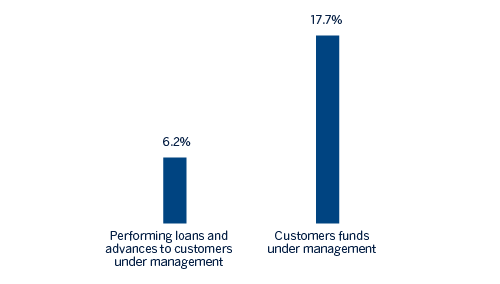
(1) Excluding repos.
Net interest income/ATAs
(Percentage. Constant exchange rate)
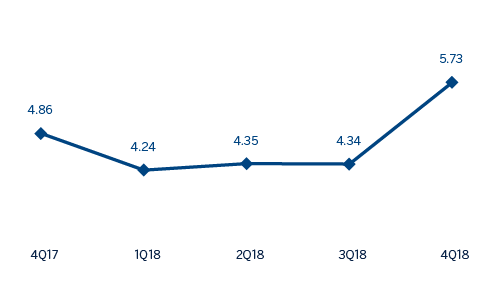
Operating income
(Millions of Euros at constant exchange rate)
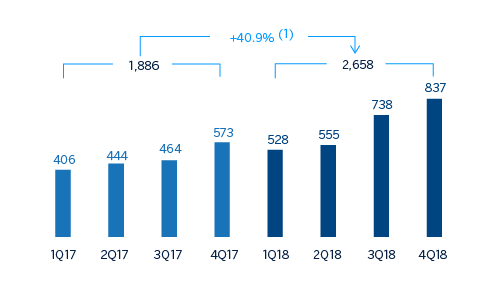
(1) At current exchange rate: +1.8%.
Net attributable profit
(Millions of Euros at constant exchange rate)
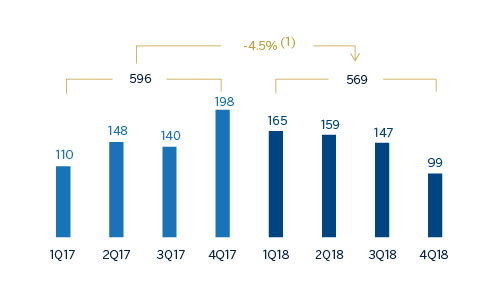
(1) At current exchange rate: -31.0%.
Breakdown of performing loans under management (1)
(31-12-2018)
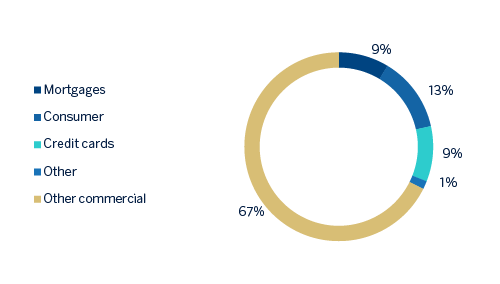
(1) Excluding repos.
Breakdown of customer funds under management (1)
(31-12-2018)

(1) Excluding repos.
Financial statements and relevant business indicators (Millions of Euros and percentage)
| IFRS 9 | IAS 39 | ||||
|---|---|---|---|---|---|
| Income statement | 2018 | ∆% | ∆%(1) | 2017 | |
| Net interest income | 3,135 | (5.9) | 30.3 | 3,331 | |
| Net fees and commissions | 686 | (2.4) | 35.1 | 703 | |
| Net trading income | 11 | (24.2) | 5.0 | 14 | |
| Other operating income and expenses | 70 | 3.4 | 43.1 | 67 | |
| Gross income | 3,901 | (5.2) | 31.3 | 4,115 | |
| Operating expenses | (1,243) | (17.3) | 14.5 | (1,503) | |
| Personnel expenses | (656) | (17.9) | 13.6 | (799) | |
| Other administrative expenses | (449) | (14.6) | 18.2 | (526) | |
| Depreciation | (138) | (22.4) | 7.5 | (178) | |
| Operating income | 2,658 | 1.8 | 40.9 | 2,612 | |
| Impairment on financial assets not measured at fair value through profit or loss | (1.202) | 165.3 | 267.4 | (453) | |
| Provisions or reversal of provisions and other results | (8) | (33.7) | (8.2) | (12) | |
| Profit/(loss) before tax | 1,448 | (32.5) | (6.6) | 2,147 | |
| Income tax | (294) | (31.0) | (4.5) | (426) | |
| Profit/(loss) for the year | 1,154 | (32.9) | (7.1) | 1,720 | |
| Non-controlling interests | (585) | (34.6) | (9.5) | (895) | |
| Net attributable profit | 569 | (31.0) | (4.5) | 826 | |
| IFRS 9 | IAS 39 | ||||
|---|---|---|---|---|---|
| Balance sheets | 31-12-18 | ∆% | ∆%(1) | 31-12-17 | |
| Cash, cash balances at central banks and other demand deposits | 7,853 | 94.6 | 159.3 | 4,036 | |
| Financial assets designated at fair value | 5,506 | (14.2) | 14.3 | 6,419 | |
| of which loans and advances | 410 | n.s. | n.s. | - | |
| Financial assets at amortized cost | 50,315 | (22.7) | 3.0 | 65,083 | |
| of which loans and advances to customers | 41,478 | (19.3) | 7.6 | 51,378 | |
| Tangible assets | 1,059 | (21.2) | 5.1 | 1,344 | |
| Other assets | 1,517 | (16.3) | 11.6 | 1,811 | |
| Total assets/liabilities and equity | 66,250 | (15.8) | 12.2 | 78,694 | |
| Financial liabilities held for trading and designated at fair value through profit or loss | 1,852 | 185.9 | 281.0 | 648 | |
| Deposits from central banks and credit institutions | 6,734 | (39.8) | (19.8) | 11,195 | |
| Deposits from customers | 39,905 | (10.7) | 19.0 | 44,691 | |
| Debt certificates | 5,964 | (28.5) | (4.8) | 8,346 | |
| Other liabilities | 9,267 | (18.1) | 9.1 | 11,321 | |
| Economic capital allocated | 2,529 | 1.4 | 35.2 | 2,493 | |
| Relevant business indicators | 31-12-18 | ∆% | ∆%(1) | 31-12-17 |
|---|---|---|---|---|
| Performing loans and advances to customers under management (2) | 40,996 | (20.3) | 6.2 | 51,438 |
| Non-performing loans | 2,876 | 12.7 | 50.1 | 2,553 |
| Customer deposits under management (2) | 39,897 | (10.4) | 19.4 | 44,539 |
| Off-balance sheet funds (3) | 2,894 | (25.8) | (1.2) | 3,902 |
| Risk-weighted assets | 56,486 | (10.0) | 19.9 | 62,768 |
| Efficiency ratio (%) | 31.9 | - | - | 36.5 |
| NPL ratio (%) | 5.3 | - | - | 3.9 |
| NPL coverage ratio (%) | 81 | - | - | 85 |
| Cost of risk (%) | 2.44 | - | - | 0.82 |
(1) Figures at constant exchange rate.
(2) Excluding repos.
(3) Includes mutual funds, pension funds and other off-balance-sheet funds.
Macro and industry trends
According to the most recent figures from the Turkish Statistical Institute, Turkey’s year-on-year economic growth was 1.6% in the third quarter of 2018, supported by the considerable positive external demand contribution, while domestic demand, including inventories, hindered growth.
Interannual inflation experienced a rapid correction as it declined from 24.5% in September to 20.3% in December, as a result of tax reductions in certain items, price discount campaigns, the contraction in oil prices and the appreciation of the Turkish lira by around 20% in the last four months of 2018.
Throughout the year, the Central Bank (CBRT) increased its funding interest rate by 1.125 basis points. However, in its December meeting the CBRT decided to keep it at 24.0%. With this decision, the CBRT strengthened its message against the easing expectations of the market, saying that risks on price stability continue to prevail despite the recent improvement in inflation outlook due to the developments in import prices and domestic demand conditions. Regarding fiscal policy stance, the government’s budget targets were met at the end of 2018 with the support of one-off revenues.
Regarding the evolution of the Turkish financial sector, year-on-year credit growth has continued to decelerate during the last quarter of 2018, mainly due to business lending. By the last week of December 2018, the year-on-year total lending growth rate (adjusted for the depreciation of the lira effect) fell to 3.1%. On the other hand, customer deposits have also shown sign of a slowdown. The year-on-year total deposits growth rate fell to 6.2% (adjusted for the depreciation of the lira effect). Turkish-lira deposits grew by 10.6% and foreign-currency deposits (mainly in U.S. dollars) contracted by 7.6%. Lastly, the NPL ratio closed at 3.66% for December 28th (an increase of 59 basis points in the last quarter).
Activity
Unless expressly stated and communicated otherwise, rates of changes explained ahead, both for activity and for income will be presented at constant exchange rates. These rates, together with changes at current exchange rates, can be observed in the attached tables of the financial statements and relevant business indicators.
The most relevant aspects related to the area’s activity year-to-date as of December 31, 2018 have been:
- Lending activity (performing loans under management) grew by 6.2% in the year driven by the evolution of exchange rates (down 11.2% in the quarter). On the one hand, Garanti Bank continued to reduce its exposure in foreign-currency loans (in U.S. dollars) in all quarters of 2018 in line with its corporate strategy; while on the other hand, Turkish-lira loan growth decelerated in the third quarter and decreased significantly in the last quarter of 2018.
- By segments, contraction has accelerated in the fourth quarter in all types of loans except auto loans and credit cards, which grew above the sector. On the contrary, the contraction in consumer and mortgage loans accelerated in the quarter in line with the sector and there was a contraction in Turkish-lira business banking loans which is in line with the private banks.
- In terms of asset quality, the NPL ratio increased to 5.3% due to the macroeconomic conditions and the inflow of certain doubtful clients. The NPL coverage ratio stood at 81%.
- Customer deposits (60% of total liabilities in the area as of December 31, 2018) remained the main source of funding for the Turkish´s balance sheet and grew by 19.4% in 2018 mainly supported by the growth of Garanti Bank Turkish-lira deposits. On the other hand, shrinkage in foreign-currency customer deposits (in U.S. dollars) continued due to higher interest rates in Turkish-lira deposits.
- All funding and liquidity ratios remained within comfort levels, and Garanti maintained its solvency levels well above requirements.
Results
In 2018, Turkey generated a cumulative attributable profit of €569m, a year-on-year decline of 4.5%. The most significant aspects of the year-on-year evolution in the income statement were as follows:
- Positive performance of net interest income (up to 30.3%) despite the pressure on customer spreads, mainly due to the significant income from inflation-linked bonds, whose contribution, compared to previous year, is more than double.
- Income from net fees and commissions grew by 35.1%. This significant increase was mainly driven by the positive performance in payment systems, advances, money transfers and other commissions.
- Increase in NTI (by 5.0%) where the high performance of global markets, asset and liabilities management and derivatives offsets the Turkish lira depreciation.
- Gross income was up 31.3% in 2018 compared to 2017, thanks to the increase in core banking activities and the aforementioned higher inflation-linked bonds contribution.
- Operating expenses increased by 14.5%, below the average inflation rate (16.2%) and well below the year-on-year growth rate in gross income. As a result of strict cost-control discipline, the efficiency ratio declined to 31.9%.
- Impairment on financial assets increased in year-on-year terms by 267.4%, mainly denominated by big ticket provisions coming from the wholesale-customer portfolio and also the macroeconomic scenario update. As a result, the cumulative cost of risk of the area increased to 2.44%.